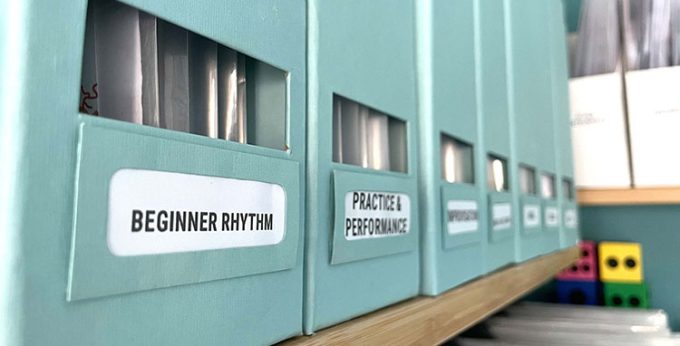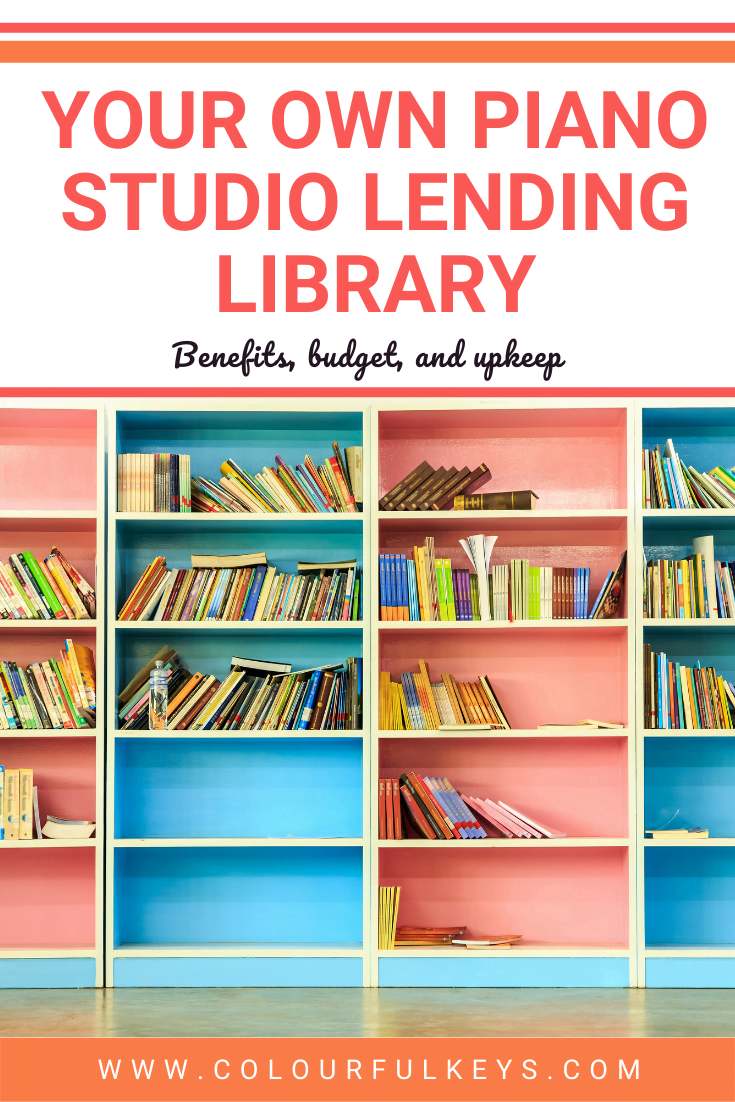Having a lending library in your piano studio is a great way to expand the resources available to your students. You can have a selection of games and books ready to go and provide a rich musical environment for them to learn all the necessary musical skills they need.
Whether you’re just starting a library or extending your existing one, there are a few things you can do to make it go more smoothly.

⬆️ Listen to the podcast above or keep on reading, whichever fits your style. ↙️
Many of the piano teachers I talk to want to set up a lending library (for games, books or both) but are hesitant to do so because of:
- The cost of the materials
- Fear of their things not being looked after
- Extra admin and organisation
While I can’t eliminate any of those factors for you, I can tell you how to minimise the issues to make it worthwhile.
Why You Should Have a Piano Studio Lending Library
Is this something you should even be spending your precious time on? I believe it can be a very valuable investment that can benefit all the students in your studio in so many ways.
Benefits of Loaning Games
Learning music doesn’t just happen when students play the piano, but also in off-the-bench activities.
Games can be taken to grandparents’ houses, played in the car on long trips, be part of family activity time and can create a shared experience away from the ever-so-often solo experience of learning the piano. They’re also a great option when kids come home tired from school.
Benefits of Loaning Books
Loaning out supplemental music books can also make practice time more fun and varied. This is not a replacement for them having their own books; however, it serves a different purpose.
Library books can be used for sight reading or exploring a new genre when your student isn’t quite sure if they’ll like it. This is something students naturally have access to when there are multiple family members who also study piano, and it’s a great thing to extend to our students who don’t happen to have a variety of music books at home.
How to Organise Your Piano Studio Lending Library
Having a reliable system is key to keeping things simple, easy, stress-free and consistent. Getting this right from the start and sticking to it should form the basis of any good lending library.
Glanceable
Games need to have clear covers displaying concepts, level and the title of the game.
We include these covers in our Vibrant Music Teaching games so you can print them and stick them on the front of the folder. If you’re using a game which doesn’t come with a cover, write on the front in clear block letters so you can read it without thinking!
Packed and Prepped
Make sure that all your games come with everything they need:
- All counters
- Dice
- Game cards separated and wrapped in elastic bands
- Game instructions
- A cheat sheet so parents can help their child at home
Categories
One subject which is commonly debated among us piano-teacher nerds is what categories to use in your library.
Options for categorising games include:
- Concepts
- Ability & Level
- Most Popular
- Exam Level
- Topic
For books and sheet music, you can try:
- Composers
- Genre
- Level
- Publisher
- Colour
There is no one-size-fits-all answer here because the trick is for YOU to be able to find it later. So instead of doing what I do or what the Ms. Jones from your association does, ask yourself…How do you remember games and books? What’s the first thing you think of?

That is what you should organise by. Even if it’s something others would find confusing or random. Because you’re the one who needs to use this library.
How to Track Items in Your Music Studio Lending Library
It’s essential to keep track of who has what and when. If you don’t, well-meaning students will forget they even have the resource and it’ll get mixed in with their stuff at home.
The simpler you can make this system, the better. Here are 3 great options for you.
Photos
Many teachers just get the student to hold up the thing they are borrowing and they take a photo of them with their phone.

You can store these photos in a special folder on your phone and just delete them when the student returns the item.
A Written List
If you’re going to write a log of the library items make sure you decide right upfront where this list is going. The last thing you want is 3 lists across different notebooks + an Evernote reminder + a note in your studio management software.
Pick one and stick to it.
To learn how I store digital resources in my studio, check out this article.
Studio Management Software
Many software options today include ready-made solutions for a lending library. For example, with My Music Staff you simply enter the game or book’s info, then click “check out” and select your student. You can even enter a due date if you want to remind yourself about it.
How to Budget for Library Additions and Upkeep
There are several things to consider when budgeting for your music teaching studio’s lending library.
Move to All-Inclusive Tuition
Lending libraries are one of the reasons why I love all-inclusive tuition.
Since I cover all the books and materials within the tuition cost, it’s up to me whether what I loan to them and give to them. I can easily buy studio licenses when it makes sense, too, and not worry about diving that cost somehow between families.
Use a Registration Fee
If all-inclusive tuition doesn’t suit you for whatever reason, consider bringing in a registration fee to fund your lending library.
You can charge this at the end of one academic year to reserve a student’s spot for the next year and use it (or part of it) to add new items and replace damaged things in your piano studio library.
Invest in Good Gadgets
This isn’t an excuse to go wild in the craft shop buying all the fancy cutting flibbidies. (I wish it was, too!)
However, there are a few key tools you’ll need to make this cost effective in the long term:
- A good printer. Don’t buy the cheapest one – always look at the cost of its ink first! If possible buy one with refillable ink cartridges to save all that plastic waste.
- A self-healing cutting mat. These are the green things you see crafters using and will save you so much heartache.
- A craft knife or scalpel (I like the Swann Morton ones with the 10A blades. Don’t get the curved “10” blades; those are the worst.😡)
- A metal ruler with cork backing so it doesn’t slip.
- A comb or wire binder (only if you don’t want to put sheet music in folders)

You’ll also need regular paper and heavier weight paper for your printer. I suggest about 160gsm for game boards and cards so that they are sturdier and not see-through. (This is what those in the US would call 60lb cardstock.)
Budget for Replacements
Listen, kids are kids. Some of these things are going to get broken, lost and eaten by hamsters. I prefer to budget for these natural occurrences rather than making families replace them or reimburse me.
The only exception would be families who are repeatedly losing or destroying the things I loan to them. In those cases, I would simply stop lending things out to them.
Your One Thing.
If you don’t already have a lending library in your music teaching studio, your homework is to put this in your budget for next year so you can get it up and running. Start with a small commitment and you can expand later with a registration fee or all-inclusive tuition model.
If you do already have a lending library in your piano studio, pick one improvement from this post that you can implement this week. Choose something small and doable, every little helps.
What are some of the systems you have in your library?
I’d love to hear your thoughts on this in the comments below. 🙂
For more organisation and productivity tips for your studio, check out my Business page!

Another option for organisation and lending – Librarything has free, easy to use cataloging software (if it has an ISBN you can upload the record, though you’d need to find your own way to title every game) and a loans system:
https://www.librarything.com/
I’ve actually never thought about this, but it sounds like a really good idea. My students always want to try something new but I worry that it’s too expensive to get their parents to buy a completely new book. Borrowing seems like the way to go!
How do you sell the idea of having your students play these games between lessons?
How do you store the larger game boards, like Buggy Bugston’s Branch Boulevard or Christmas Tree Climb?
They’re all made of A4 pages so they fold up and store the same way.